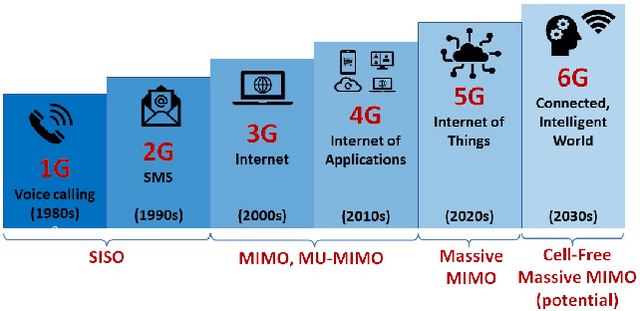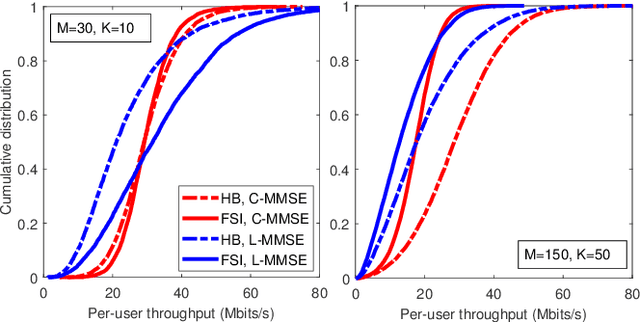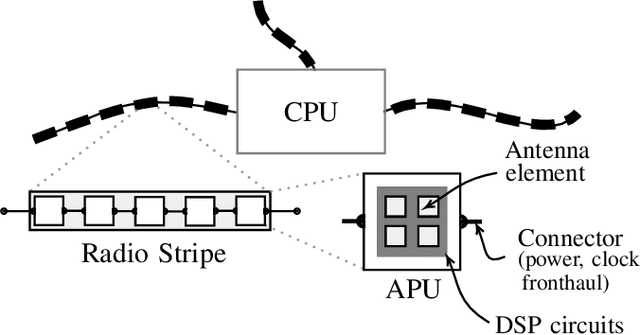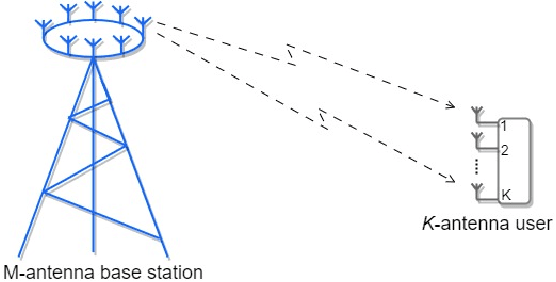Giovanni Interdonato
Joint Optimization of Uplink and Downlink Power in Full-Duplex Integrated Access and Backhaul
Apr 05, 2025Abstract:We examine the performance of an Integrated Access and Backhaul (IAB) node as a range extender for beyond-5G networks, focusing on the significant challenges of effective power allocation and beamforming strategies, which are vital for maximizing users' spectral efficiency (SE). We present both max-sum SE and max-min fairness power allocation strategies, to assess their effects on system performance. The results underscore the necessity of power optimization, particularly as the number of users served by the IAB node increases, demonstrating how efficient power allocation enhances service quality in high-load scenarios. The results also show that the typical line-of-sight link between the IAB donor and the IAB node has rank one, posing a limitation on the effective SEs that the IAB node can support.
Leveraging Line-of-Sight Propagation for Near-Field Beamfocusing in Cell-Free Networks
Mar 27, 2025Abstract:Cell-free (CF) massive multiple-input multiple-output (MIMO) is a promising approach for next-generation wireless networks, enabling scalable deployments of multiple small access points (APs) to enhance coverage and service for multiple user equipments (UEs). While most existing research focuses on low-frequency bands with Rayleigh fading models, emerging 5G trends are shifting toward higher frequencies, where geometric channel models and line-of-sight (LoS) propagation become more relevant. In this work, we explore how distributed massive MIMO in the LoS regime can achieve near-field-like conditions by forming artificially large arrays through coordinated AP deployments. We investigate centralized and decentralized CF architectures, leveraging structured channel estimation (SCE) techniques that exploit the line-of-sight properties of geometric channels. Our results demonstrate that dense distributed AP deployments significantly improve system performance w.r.t. the case of a co-located array, even in highly populated UE scenarios, while SCE approaches the performance of perfect CSI.
Eliminating Phase Misalignments in Cell-Free Massive MIMO via Differential Transmission
Mar 06, 2025Abstract:This paper proposes two approaches for overcoming access points' phase misalignment effects in the downlink of cell-free massive MIMO (CF-mMIMO) systems. The first approach is based on the differential space-time block coding technique, while the second one is based on the use of differential modulation schemes. Both approaches are shown to perform exceptionally well and to restore system performance in CF-mMIMO systems where phase alignment at the access points for downlink joint coherent transmission cannot be achieved.
User Subgrouping in Scalable Cell-Free Massive MIMO Multicasting Systems
Sep 18, 2024Abstract:Cell-free massive multiple-input multiple-output (CF-mMIMO) is a breakthrough technology for beyond-5G systems, designed to significantly boost the energy and spectral efficiencies of future mobile networks while ensuring a consistent quality of service for all users. Additionally, multicasting has gained considerable attention recently because physical-layer multicasting offers an efficient method for simultaneously serving multiple users with identical service demands by sharing radio resources. Typically, multicast services are delivered either via unicast transmissions or a single multicast transmission. This work, however, introduces a novel subgroup-centric multicast CF-mMIMO framework that divides users into several multicast subgroups based on the similarities in their spatial channel characteristics. This approach allows for efficient sharing of the pilot sequences used for channel estimation and the precoding filters used for data transmission. The proposed framework employs two scalable precoding strategies: centralized improved partial MMSE (IP-MMSE) and distributed conjugate beam-forming (CB). Numerical results show that for scenarios where users are uniformly distributed across the service area, unicast transmissions using centralized IP-MMSE precoding are optimal. However, in cases where users are spatially clustered, multicast subgrouping significantly improves the sum spectral efficiency (SE) of the multicast service compared to both unicast and single multicast transmission. Notably, in clustered scenarios, distributed CB precoding outperforms IP-MMSE in terms of per-user SE, making it the best solution for delivering multicast content.
* 6 pages, 5 figures, European Wireless 2024 Conference
User Subgrouping and Power Control for Multicast Massive MIMO over Spatially Correlated Channels
Sep 18, 2024Abstract:Massive multiple-input-multiple-output (MIMO) is unquestionably a key enabler of the fifth-generation (5G) technology for mobile systems, enabling to meet the high requirements of upcoming mobile broadband services. Physical-layer multicasting refers to a technique for simultaneously serving multiple users, demanding for the same service and sharing the same radio resources, with a single transmission. Massive MIMO systems with multicast communications have been so far studied under the ideal assumption of uncorrelated Rayleigh fading channels. In this work, we consider a practical multicast massive MIMO system over spatially correlated Rayleigh fading channels, investigating the impact of the spatial channel correlation on the favorable propagation, hence on the performance. We propose a subgrouping strategy for the multicast users based on their channel correlation matrices' similarities. The proposed subgrouping approach capitalizes on the spatial correlation to enhance the quality of the channel estimation, and thereby the effectiveness of the precoding. Moreover, we devise a max-min fairness (MMF) power allocation strategy that makes the spectral efficiency (SE) among different multicast subgroups uniform. Lastly, we propose a novel power allocation for uplink (UL) pilot transmission to maximize the SE among the users within the same multicast subgroup. Simulation results show a significant SE gain provided by our user subgrouping and power allocation strategies. Importantly, we show how spatial channel correlation can be exploited to enhance multicast massive MIMO communications.
* 14 pages, 25 figures
Energy Efficiency Optimization in Integrated Satellite-Terrestrial UAV-Enabled Cell-Free Massive MIMO
Jul 24, 2024Abstract:Integrating cell-free massive MIMO (CF-mMIMO) into satellite-unmanned aerial vehicle (UAV) networks offers an effective solution for enhancing connectivity. In this setup, UAVs serve as access points (APs) of a terrestrial CF-mMIMO network extending the satellite network capabilities, thereby ensuring robust, high-quality communication links. In this work, we propose a successive convex approximation algorithm for maximizing the downlink energy efficiency (EE) at the UAVs under per-UAV power budget and user quality-of-service constraints. We derive a closed-form expression for the EE that accounts for maximum-ratio transmission and statistical channel knowledge at the users. Simulation results show the effectiveness of the proposed algorithm in maximizing the EE at the UAV layer. Moreover, we observe that a few tens of UAVs transmitting with a fine-tuned power are sufficient to empower the service of satellite networks and significantly increase the spectral efficiency.
Ultra-Dense Cell-Free Massive MIMO for 6G: Technical Overview and Open Questions
Jan 08, 2024



Abstract:Ultra-dense cell-free massive multiple-input multiple-output (CF-MMIMO) has emerged as a promising technology expected to meet the future ubiquitous connectivity requirements and ever-growing data traffic demands in 6G. This article provides a contemporary overview of ultra-dense CF-MMIMO networks, and addresses important unresolved questions on their future deployment. We first present a comprehensive survey of state-of-the-art research on CF-MMIMO and ultra-dense networks. Then, we discuss the key challenges of CF-MMIMO under ultra-dense scenarios such as low-complexity architecture and processing, low-complexity/scalable resource allocation, fronthaul limitation, massive access, synchronization, and channel acquisition. Finally, we answer key open questions, considering different design comparisons and discussing suitable methods dealing with the key challenges of ultra-dense CF-MMIMO. The discussion aims to provide a valuable roadmap for interesting future research directions in this area, facilitating the development of CF-MMIMO MIMO for 6G.
On the Coexistence of eMBB and URLLC in Multi-cell Massive MIMO
Jan 09, 2023



Abstract:The non-orthogonal coexistence between the enhanced mobile broadband (eMBB) and the ultra-reliable low-latency communication (URLLC) in the downlink of a multi-cell massive MIMO system is rigorously analyzed in this work. We provide a unified information-theoretic framework blending an infinite-blocklength analysis of the eMBB spectral efficiency (SE) in the ergodic regime with a finite-blocklength analysis of the URLLC error probability relying on the use of mismatched decoding, and of the so-called saddlepoint approximation. Puncturing (PUNC) and superposition coding (SPC) are considered as alternative downlink coexistence strategies to deal with the inter-service interference, under the assumption of only statistical channel state information (CSI) knowledge at the users. eMBB and URLLC performances are then evaluated over different precoding techniques and power control schemes, by accounting for imperfect CSI knowledge at the base stations, pilot-based estimation overhead, pilot contamination, spatially correlated channels, the structure of the radio frame, and the characteristics of the URLLC activation pattern. Simulation results reveal that SPC is, in many operating regimes, superior to PUNC in providing higher SE for the eMBB yet achieving the target reliability for the URLLC with high probability. Moreover, PUNC might cause eMBB service outage in presence of high URLLC traffic loads. However, PUNC turns to be necessary to preserve the URLLC performance in scenarios where the multi-user interference cannot be satisfactorily alleviated.
Approaching Massive MIMO Performance with Reconfigurable Intelligent Surfaces: We Do Not Need Many Antennas
Mar 14, 2022



Abstract:This paper considers an antenna structure where a (non-large) array of radiating elements is placed at short distance in front of a reconfigurable intelligent surface (RIS). This structure is analyzed as a possible emulator of a traditional MIMO antenna with a large number of active antenna elements and RF chains. Focusing on both the cases of active and passive RIS, we tackle the issues of channel estimation, downlink signal processing, power control, and RIS configuration optimization. With regard to the last point, an optimization problem is formulated and solved, both for the cases of active and passive RIS, aimed at minimizing the channel signatures cross-correlations and thereby reducing the interference. Downlink spectral efficiency (SE) formulas are also derived by using the popular hardening lower-bound. Numerical results, represented with reference to max-fairness power control, show that the proposed structure is capable of outperforming conventional non-RIS aided MIMO systems even when the MIMO system has a considerably larger number of antennas and RF chains. The proposed antenna structure is thus shown to be able to approach massive MIMO performance levels in a cost-effective way with reduced hardware resources.
The Promising Marriage of Mobile Edge Computing and Cell-Free Massive MIMO
Feb 15, 2022


Abstract:This paper considers a mobile edge computing-enabled cell-free massive MIMO wireless network. An optimization problem for the joint allocation of uplink powers and remote computational resources is formulated, aimed at minimizing the total uplink power consumption under latency constraints, while simultaneously also maximizing the minimum SE throughout the network. Since the considered problem is non-convex, an iterative algorithm based on sequential convex programming is devised. A detailed performance comparison between the proposed distributed architecture and its co-located counterpart, based on a multi-cell massive MIMO deployment, is provided. Numerical results reveal the natural suitability of cell-free massive MIMO in supporting computation-offloading applications, with benefits over users' transmit power and energy consumption, the offloading latency experienced, and the total amount of allocated remote computational resources.
 Add to Chrome
Add to Chrome Add to Firefox
Add to Firefox Add to Edge
Add to Edge